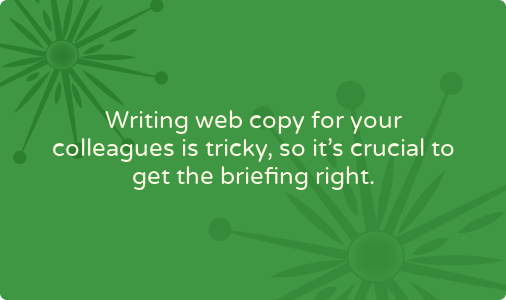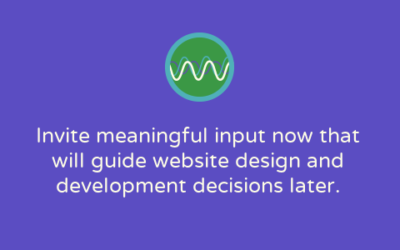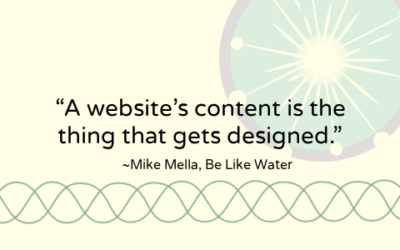Earlier this year, I wrote about productive ways to request a review of your copy. Based on the popularity of that post, it’s obvious that many nonprofit communicators struggle with writing for internal clients. So today, I’m taking several steps back to talk about web copy briefings; a smooth copy development and review process depends so much on your initial briefing.
I’m focusing on web copy in this post because it can be particularly touchy: internal clients can be defensive and have unrealistic expectations. Trying to get a written creative brief from players outside of the marcom can be challenging with an incomplete or useless brief as the result. A brief can become a barrier that gets you stuck, and a poorly written brief is of no use to you.
What’s the alternative? An in-person, phone or video call briefing: a conversation.
How to facilitate a web copy briefing conversation
After working through countless web copy projects and receiving half-completed and uninformative copy briefs, I’ve learned that the best results come from a briefing conversation. A conversation gives you room to create a collaborative atmosphere, probe incomplete answers, and work through areas of uncertainty together.
Asking the right questions in a briefing will help you write strategically aligned, audience-centred copy that is persuasive and hits essential points. To ensure you’re asking the right web copy briefing questions, I’m sharing mine with you. Use them as a guide, adapting them for your context, start with those that work best for you, and keep others ready to unearth additional details or nuances in your conversation.
Start your conversation with strategic alignment. Ask:
- Why do we need this page or section? What is it?
- What are the strategic goals you are working toward?
- How can the web copy support the specific steps toward those goals?
- In what ways do you hope this content will support your work?
- What does this page/section need to do?
Why: Your internal clients have business priorities and objectives – the web copy should support them.
Centre your audience in the copy. Ask:
- How would you describe the primary audience for this page?
- Why is this audience important to our organization?
- What are their needs related to the work we’re featuring on this page? What matters to them?
- What situations would bring a member of this audience to this page?
- What questions are they seeking to get answered? What information can we provide to answer those questions?
Why: If your internal clients are overly internally focussed (many are), these questions help to meet your audiences in the middle. Also, you’ll write better copy if you can tap into internal clients’ insights about their audiences – and they’ll appreciate that you asked.
Develop a focus and key message. Ask:
- What key points does the page need to communicate and include?
- If this page was a person speaking to a member of this audience, what would you want it to say?
Why: People often want to be comprehensive in web copy, but that could come at the expense of clarity. Asking about “key” points or “main” messages will help you prioritize and hit the mark with your copy.
Shape your call to action. Ask:
- What actions will visitors want to take on this page?
- What action do we want them to take?
- What call to action do we need to feature on this page?
Why: You should structure your copy in a way that leads to engagement on your website. Decide what this should be together, before you start writing.
Start gathering background and other content. Ask:
- Do we have any testimonials or other belief builders that we can include in this copy?
- What additional relevant background information or existing materials should I look at when building this page?
Why: Rounding up testimonials and other background information can take time, so it helps to start right away.
For existing pages, ask:
- What is the URL of the existing page – the page to be updated or replaced?
- What parts of this content are currently working or not working?
Why: People will want to vent about old and outdated web pages. Give them space to vent (you’ll likely glean valuable insights) but do it at the end of the conversation, so it doesn’t derail your briefing. If the venting starts early on, indicate, “I’m going ask about the existing copy soon. For now, I’d like to ask about…”
Writing web copy for your colleagues is tricky, so it's crucial to get the briefing right. #NPMC Click To TweetSetting aside the time for a web copy briefing conversation is worth it.
If a briefing conversation feels much less appealing than asking for a completed brief… I get it; you’re busy. But starting with a briefing conversation will go a long way toward building consensus and making people feel included in the right way. You’ll also save time in the long run, by producing a solid first draft that requires fewer revisions and less back and forth.
Note: your briefing may not always go as smoothly as you’d like. Your internal clients may be fully prepared to answer some questions and utterly baffled by others. That’s where you step in as a communicator who knows your organization and can fill in the blanks.
Most of the time, however, these conversations will go well, your colleagues will see you in a strategic, helpful and capable light, and you’ll get what you need to write terrific web copy. After working through briefings, I often get comments like, “I didn’t think I’d have anything to offer this conversation,” and “I’ve never thought about web copy in this way!”
Finally, if this all sounds great but you don’t have the time to give your organization’s web copy the attention it needs, let’s talk. I’ve helped many nonprofit communicators produce the web copy they need – and navigate tricky internal customers – through my website copywriting package for nonprofit organizations. Check out the package and set up a consultation if you’d like to talk more.
Web copy briefings done right: have a conversation, ask the right questions #NPMC Click To Tweet



